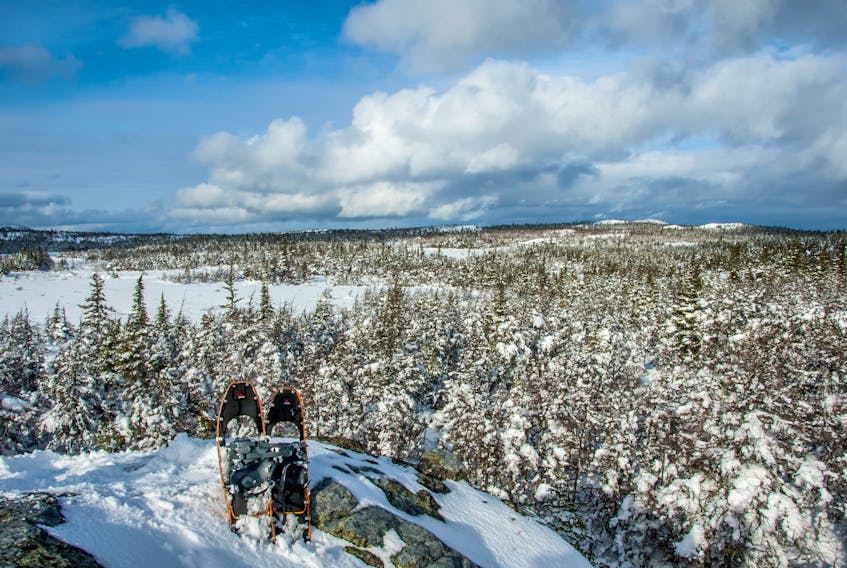There’s more snow coming tomorrow morning, but it’s forecasted to transform into rain around noon.
The temperature is supposed to rise abruptly to six or seven
Celsius in the mid afternoon and then freeze tomorrow night. It’s minus 13 right now at about 8 p.m.
That is one crazy wild ride.

And there will be high winds again tomorrow, no stranger, and this time from the south. That will seriously melt some snow.
But just the same, it will be a good idea to get outside and clear the snow that falls tomorrow morning before the rain and warm wind transforms it to slush. I don’t like shoveling or plowing slush.
It was even worse years ago when I used a snowblower. My old snowblower was absolutely useless in soggy wet stuff.
My quad with a five-foot plow doesn’t complain quite as much.
If the wind isn’t too vicious I’ll try and get out on my snowshoes tomorrow before too much rain falls.
I have a good raincoat, and pants as well.

You know what? If you waited for perfect weather to get outside during an Avalon Peninsula winter you’d spend a lot of time in the house.
And as I said many times before, I hate treadmills. I prefer to go out in the rain, snow, sleet, hail, wind, or whatever. There is no bad weather, only inadequate gear — cliché but true I think.
We will see what tomorrow brings.
I have to tell you about my new snowshoes.
I know, I hear you out there, “what in the name of God does he need with more snowshoes?”
Goldie said it loud and clear when I came home from the post office with a big cardboard box and opened it up on the dining room table.
I heard something about filling the place up with snowshoes, fishing rods, guns and the like. I believe I might have heard something about duck decoys, as well.
But it was like water off a duck’s back — pun and cliché again, but very appropriate. Me being far too enthusiastic about my new racquets, didn’t skip a beat of cutting tape and unpacking.
“Wow, these look great.”
Goldie didn’t bother to look.
These snowshoes are very different then the new ones I bought myself for Christmas.
I am a master of new gear rationalization.
Goldie doesn’t buy it.
I am addicted to snowshoes and I do need group therapy. Anybody out there for a retreat in the woods on the powder?
No, that won’t help. Anyway, different how you ask? Snowshoes stop you from sinking in the snow. Seems straightforward, but no. Winter trekking just isn’t that simple, and it’s a bit of a story.
A few weeks ago I called Faber Snowshoes, a Quebec-based company which has been manufacturing snowshoes since 1870. That’s a long time and they know snow. I spoke with the co-owner of the company Guy Faber. My intention was to talk about Ojibwa style shoes for deep powder.
After some quite interesting conversation about snowshoe design Guy excitedly began telling me about Faber’s new sliding step style of snowshoe.
They are called S-line if you want to look them up and they come in three sizes. I got the big ones for maximum floatation, 46-inches long and 6.5-inches wide.
This enormous footprint can keep one afloat in very deep fluffy snow, even with a heavy pack on. That’s what I wanted, for backwoods deep snow travel.
There’s far more to these S-line shoes than brute force floatation.

I’ll explain. The Ojibwa people lived primarily in open country where deep snows covered the land for much of the winter. Their style of snowshoe reflects the geography and climate of the land that sustained them. Their racquets were long, around five-ft and typically pointed on both ends. I’m still hoping to buy a traditional pair very soon. I want to walk to my cabin with them after a big storm. Anyway, Faber’s S-line shoe is the modern high-tech incarnation of the ancient Ojibwa snowshoe. I was intrigued.
It’s not just shoe geometry, profile, or materials. As a trekker moves from shorter to longer shoes, one’s optimum stride should also adjust.
Ojibwa snowshoes and their modern S-line counterparts are meant to be used most efficiently through a cross-country skiing sort of gait. The idea is to lift the toe and kick the shoe forward while dragging the tail of the shoe along the snow.
This stride is most energy efficient in deep snow. Using my S-line racquets I could even get a decent glide on the trail, like you would using the classic Nordic skiing style. Last Saturday morning I was logging under 20-minute miles in deep snow. That is fast for me.
Most of the modern snowshoes that we see in stores these days are designed primarily for hard packed trails and crusty conditions.
That’s not necessary a bad thing because we get a lot of that here on the Avalon Peninsula. And if you snowshoe in city parks and the like, the trails are sure to be pounded down soon after a snowfall.

I’m a big fan of MSR snowshoes, with their flat metal serrated traction edges, and aggressive underfoot crampons. And they tend to be no longer than 25-inches. MSR stands for Mountain Safety Research and alpine is the focus of their research and development.
Alpine snow is typically hard packed from winds and often crusty. These shoes are wicked on steep slopes.
I climbed Maul Tree Hill with my MSR 25-inch Revo Assent shoes last week. The slope was quite icy and the crampons really dug in.
There are no crampons or serrated edges on these Faber S-line shoes.
I would not try to climb a mountain with them, but boy oh boy are they ever fun and fast on rolling hilly terrain.
Traction can be adjusted using skins that come with the shoes. Essentially these are removable rough patches, one in the front and one behind. So you have four patches that can be flipped over to go from moderate to solid traction. You could have less traction on the front and more on the back, or vice versa, depending on preference and terrain. Or you can leave the skins off altogether for full-bore sport mode. Then you could fly down the hill like on skis. I haven’t tried that yet. These shoes I think could be classified as a crossover between skis and snowshoes.
I love them.
Stay tuned for more from the snowy woods. Winter is far from over.
Paul Smith, a native of Spaniard’s Bay, fishes and wanders the outdoors at every opportunity. He can be contacted at [email protected] or follow him on twitter at @flyfishtherock.









